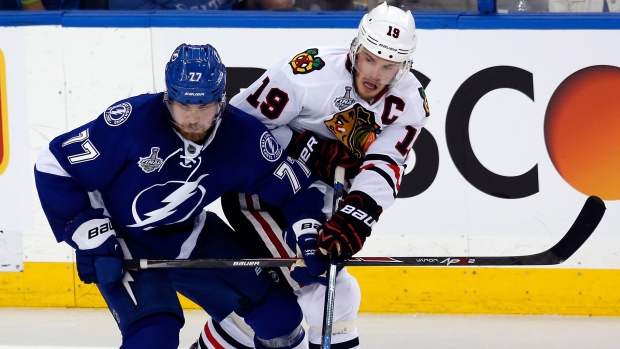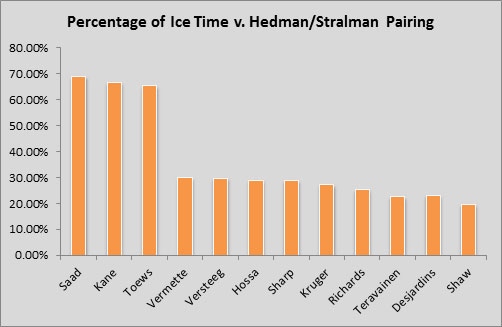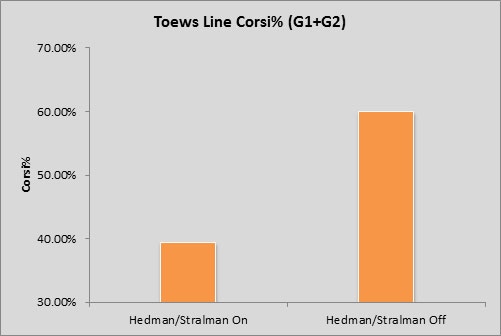Jun 8, 2015
Tampa's top D winning matchup with Toews line
If there was one takeaway from the opening two games of the Stanley Cup Final, it’s that very little separates the Tampa Bay Lightning and Chicago Blackhawks. If Chicago is going to have an advantage on home ice, it may be in whether Joel Quenneville can get Jonathan Toews' line away from Tampa Bay's top defence pair of Victor Hedman and Anton Stralman.
By Travis Yost

If there was one takeaway from the opening two games of the Stanley Cup Final, it’s that very little separates the Tampa Bay Lightning and Chicago Blackhawks.
Down in Tampa Bay, the numbers were impressively close. Wins were one apiece. Goals were four apiece. Shots on goal were 42 apiece. Chicago had a slight edge in overall shot-attempts (83 to 72), but Tampa Bay a slight edge in scoring chances (41-35).
Ultimately, you get the sense that the margins could very well decide the victor in this series. Which is why it’ll be fascinating to pay attention to what Joel Quenneville does for games three and four with the series shifting back to Chicago.
One of the things the Blackhawks really need to do is get their premier talent away from Tampa Bay’s vaunted Anton Stralman/Victor Hedman defence pairing, which may be as good as any duo in the league. We have talked about Stralman at length this postseason, but it’s worth noting that his partner is world-class in his own right.
On home ice, Jon Cooper did well to get his top talent matched against Chicago’s top talent. I don’t think there’s much of a secret to what Cooper was doing here – the percentage of ice-time in which the Blackhawks’ top line saw the Hedman/Stralman pairing was ridiculous through the two games:

Of Chicago’s top-line, there’s just one even strength point to show through after the split down in Tampa Bay – a Jonathan Toews assist on Brent Seabrook’s third-period goal in Game Two.
Speaking realistically for a moment, there’s often little an opposing team can do over a longer period of time to keep a trio as talented as Jonathan Toews, Patrick Kane, and Brandon Saad from filling up the stat sheet. They’re lethal with the puck, they’re exceptional attacking in transition and on the cycle, and defensively, they don’t yield much.
There is indisputable individual talent within each player on the line, but their success is very much predicated on the fact that they often enjoy sustained shifts of offensive zone pressure, generating shots and chances in bunches. More often than not, they win on sheer quantity.
The best way to limit the Toews group isn’t to simply play a defensively-responsible game – they are too talented – and even perfect systems play and deployment will be exposed from time to time. A team’s best shot is to beat the Toews group back into their end, making them work off of the puck, and applying periods of sustained pressure that will mitigate the number of shots and chances the group can generate.
This brings us back to the play of Hedman/Stralman, who were able to do just that in the first two games of the Final. We can pull out the shot attempt data for the Toews group in periods of time against the Hedman/Stralman pairing and against Tampa Bay’s second and third pairings to illustrate just how strong of a performance this was:

So, why are Jonathan Toews, et al. goalless at EV through the first two games? Surely part of it is because we are isolating on just two games of data. But, part of it is also because they just haven’t tasted the same kind of offensive zone time that they’ve experienced against most other forms of competition. Hedman/Stralman have forced the Toews group to defend on a larger percentage of their shifts, and so far, it’s paying dividends.
I anticipate Joel Quenneville will work the Toews group away from Hedman/Stralman in games three and four at United Center, so now the test shifts to Tampa Bay’s second pairing of Jason Garrison and Braydon Coburn.
Can they handle the expected increase in quality of competition? If so, Jon Cooper’s job just got an awful lot easier. If not, life on the road could get miserable in a hurry.

